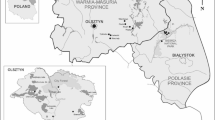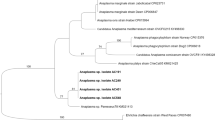Abstract
This study presents the results of the molecular detection of tick-borne microorganisms in Amblyomma tigrinum Koch collected near the city of Viedma, Río Negro, Argentina. Ticks were collected in their non-parasitic stage, on pet dogs and on Lycalopex gymnocercus (Pampa fox). Also, six tick samples from humans were analyzed. All ticks were morphologically identified to species level and genomic DNA was extracted. The DNA samples were examined by end point PCR assays to amplified DNA of Anaplasma sp., Babesia sp., Ehrlichia sp., Rickettsia sp. and Theileria sp. Although all tested DNA samples from the collected ticks resulted negative to the detection of Piroplasmida and Rickettsia spp., 16 samples (16.5%, including all hosts) were positive in the 16S rDNA gene PCR that detects bacteria from the Anaplasmataceae family. Phylogenetic analysis of seven obtained partial sequences resulted in the identification of three bacteria: two Ehrlichia spp. (related to Ehrlichia sp. strain Iberá and strain Viedma) and Candidatus Anaplasma boleense. The latter finding represents the first detection of this novel Candidatus species in A. tigrinum. Based on the results of this study, it must be assumed that the diversity of bacteria of the Anaplasmataceae family in Argentina is greater than previously thought, and that these bacteria can infect a wide range of domestic and wild animals.

Similar content being viewed by others
Data availability
Not applicable.
References
Aguiar DM, Hagiwara MK, Labruna MB (2008) In vitro isolation and molecular characterization of an Ehrlichia canis strain from São Paulo, Brazil. Braz J Microbiol 39:489–493. https://doi.org/10.1590/S1517-838220080003000014
Cicuttin GL, De Salvo MN, Nava S (2017) Two novel Ehrlichia strains detected in Amblyomma tigrinum ticks associated to dogs in peri-urban areas of Argentina. Comp Immunol Microbiol Infect Dis 53:40–44. https://doi.org/10.1016/j.cimid.2017.07.001
Cicuttin GL, De Salvo MN, Pérez PD, Silva D, Félix ML, Venzal JM, Nava S (2020) A novel Ehrlichia strain (Rickettsiales: Anaplasmataceae) detected in Amblyomma triste (Acari: Ixodidae), a tick species of public health importance in the Southern Cone of America. Pathog Glob Health 114:318–322. https://doi.org/10.1080/20477724.2020.1795579
Cuervo PF, Flores FS, Venzal JM, Nava S (2021) Niche divergence among closely related taxa provides insight on evolutionary patterns of ticks. J Biogeogr 00:1–12. https://doi.org/10.1111/jbi.14245
Dumler JS, Barbet AF, Bekker CP, Dasch GA, Palmer GH, Ray SC, Rikihisa Y, Rurangirwa FR (2001) Reorganization of genera in the families Rickettsiaceae and Anaplasmataceae in the order Rickettsiales: unification of some species of Ehrlichia with Anaplasma, Cowdria with Ehrlichia and Ehrlichia with Neorickettsia, descriptions of six new species combinations and designation of Ehrlichia equi and ‘HGE agent’ as subjective synonyms of Ehrlichia phagocytophila. Int J Syst Evol Microbiol 51:2145–2165. https://doi.org/10.1099/00207713-51-6-2145
Dumler JS, Rikihisa Y, Dasch GA (2015) Anaplasmataceae. Bergey’s manual of systematics of Archaea and bacteria. Wiley, Hoboken. https://doi.org/10.1002/9781118960608.fbm00176
Eberhardt AT, Fernandez C, Fargnoli L, Beldomenico PM, Monje LD (2020) A putative novel strain of Ehrlichia infecting Amblyomma tigrinum associated with pampas fox (Lycalopex gymnocercus) in Esteros Del Ibera ecoregion, Argentina. Ticks Tick Borne Dis 11:101318. https://doi.org/10.1016/j.ttbdis.2019.101318
Fargnoli L, Fernadez C, Monje LD (2020) Novel Ehrlichia strain infecting cattle tick Amblyomma neumanni, Argentina. Emerg Infect Dis 26:1027–1030. https://doi.org/10.3201/eid2605.190940
Fernandes SJ, Matos CA, Freschi CR, de Souza Ramos IA, Machado RZ, André MR (2019) Diversity of Anaplasma species in cattle in Mozambique. Ticks Tick Borne Dis 10:651–664. https://doi.org/10.1016/j.ttbdis.2019.02.012
Flores FS, Saracho-Bottero MN, Tarragona EL, Sebastian PS, Copa GN, Guardia L, Mangold AJ, Venzal JM, Nava S (2023) Ticks (Acari: Ixodidae, Argasidae) associated with wild birds in Argentina. Ticks Tick Borne Dis 14:102135. https://doi.org/10.1016/j.ttbdis.2023.102135
Frutos R, Viari A, Ferraz C, Morgat A, Eychenié S, Kandassamy Y, Chantal I, Bensaid A, Coissac E, Vachiery N, Demaille J, Martinez D (2006) Comparative genomic analysis of three strains of Ehrlichia ruminantium reveals an active process of genome size plasticity. J Bacteriol 188:2533–2542. https://doi.org/10.1128/JB.188.7.2533-2542.2006
Godagnone RF, Bran DE (2009) Inventario Integrado De Los recursos naturales de la provincia de Río Negro. INTA, Buenos Aires (Argentina)
Guglielmone AA, Nava S, Robbins RG (2021) Neotropical hard ticks (Acari: Ixodida: Ixodidae): a critical analysis of their taxonomy, distribution, and host relationships. Springer, Berlin, p 486
Guo WP, Tian JH, Lin XD, Ni XB, Chen XP, Liao Y, Yang SY, Dumler JS, Holmes EC, Zhang YZ (2016) Extensive genetic diversity of Rickettsiales bacteria in multiple mosquito species. Sci Rep 6:38770. https://doi.org/10.1038/srep38770
Hall TA (1999) BioEdit: a user-friendly biological sequence alignment editor and analysis program for Windows 95/98/NT. Nucleic Acids Symp Ser 41:95–98
Kang YJ, Diao XN, Zhao GY, Chen MH, Xiong Y, Shi M, Fu WM, Guo YJ, Pan B, Chen XP, Holmes EC, Gillespie JJ, Dumler SJ, Zhang YZ (2014) Extensive diversity of Rickettsiales bacteria in two species of ticks from China and the evolution of the Rickettsiales. BMC Evol Biol 14:167. https://doi.org/10.1186/s12862-014-0167-2
Koh FX, Panchadcharam C, Sitam FT, Tay ST (2018) Molecular investigation of Anaplasma spp. in domestic and wildlife animals in Peninsular Malaysia. Vet Parasitol Reg Stud Rep 13:141–147. https://doi.org/10.1016/j.vprsr.2018.05.006
Krawczak FS, Binder LC, Gregori F, Martins TF, Pádua GT, Sponchiado J, Melo GL, Polo G, Labruna MB (2023) Candidatus Rickettsia Andeanae’ and probable exclusion of Rickettsia parkeri in ticks from dogs in a natural area of the Pampa biome in Brazil. Pathogens 12(3):446. https://doi.org/10.3390/pathogens12030446
Kumar S, Stecher G, Li M, Knyaz C, Tamura K (2018) MEGA X: molecular evolutionary genetics analysis across computing platforms. Mol Biol Evol 35:1547–1549. https://doi.org/10.1093/molbev/msy096
Labruna MB, Whitworth T, Horta MC, Bouyer DH, McBride JW, Pinter A, Popov V, Gennari SM, Walker DH (2004) Rickettsia species infecting Amblyomma cooperi ticks from an area in the state of São Paulo, Brazil, where Brazilian spotted Fever is endemic. J Clin Microbiol 42:90–98. https://doi.org/10.1128/JCM.42.1.90-98.2004
Lartigau B, Aprile G, Monteverde M, Beade MS, Lartigau JM, Valenzuela AEJ, Funes M, Mezzabotta A (2019) Canis lupus familiaris. En: SAyDS–SAREM (eds) Categorización 2019 de los mamíferos de Argentina según su riesgo de extinción. Lista Roja de los mamíferos de Argentina. Versión digital http://cma.sarem.org.ar
Lu M, Tian JH, Yu B, Guo WP, Holmes EC, Zhang YZ (2017) Extensive diversity of rickettsiales bacteria in ticks from Wuhan, China. Ticks Tick Borne Dis 8:574–580. https://doi.org/10.1016/j.ttbdis.2017.03.006
Luengos Vidal E, Farías A, Valenzuela AEJ, Caruso N (2019) Lycalopex gymnocercus. En: SAyDS–SAREM (eds) Categorización 2019 de los mamíferos de Argentina según su riesgo de extinción. Lista Roja de los mamíferos de Argentina. Versión digital http://cma.sarem.org.ar
Millán J, Travaini A, Cevidanes A, Sacristán I, Rodríguez A (2018) Assessing the natural circulation of canine vector-borne pathogens in foxes, ticks and fleas in protected areas of Argentine Patagonia with negligible dog participation. Int J Parasitol Parasit Wildl 8:63–70. https://doi.org/10.1016/j.ijppaw.2018.11.007
Monje LD, Fernandez C, Percara A (2019) Detection of Ehrlichia sp. strain San Luis and Candidatus Rickettsia andeanae in Amblyomma parvum ticks. Ticks Tick-Borne Dis 10:111–114. https://doi.org/10.1016/j.ttbdis.2018.09.008
Nava S, Venzal JM, González-Acuña D, Martins TF, Guglielmone AA (2017) Ticks of the Southern Cone of America: diagnosis, distribution and hosts with taxonomy, ecology and sanitary importance. Elsevier, Academic Press, London, p 352
Oyarzabal M, Clavijo J, Oakley L, Biganzoli F, Tognetti P, Barberis I, Maturo HM, Aragón R, Campanello PI, Prado D, Oesterheld M, León RJC (2018) Unidades De vegetación De La Argentina. Ecol Austral 28:40–63
Parola P, Paddock CD, Socolovschi C, Labruna MB, Mediannikov O, Kernif T, Abdad MY, Stenos J, Bitam I, Fournier PE, Raoult D (2013) Update on tick-borne rickettsioses around the world: a geographic approach. Clin Microbiol Rev 26:657–702. https://doi.org/10.1128/CMR.00032-13
Pía MV, Novaro AJ, Lucherini M, Reppucci JI, Valenzuela AEJ (2019) Lycalopex culpaeus. En: SAyDS–SAREM (eds) Categorización 2019 de los mamíferos de Argentina según su riesgo de extinción. Lista Roja de los mamíferos de Argentina. Versión digital http://cma.sarem.org.ar
Rar V, Tkachev S, Tikunova N (2021) Genetic diversity of Anaplasma bacteria: twenty years later. Infect Genet Evol 91:104833. https://doi.org/10.1016/j.meegid.2021.104833
Romer Y, Nava S, Govedic F, Cicuttin G, Denison AM, Singleton J, Kelly AJ, Kato CY, Paddock CD (2014) Rickettsia parkeri rickettsiosis in different ecological regions of Argentina and its association with Amblyomma tigrinum as a potential vector. Am J Trop Med Hyg 91:1156–1160. https://doi.org/10.4269/ajtmh.14-0334
Saracho Bottero MN, Tarragona EL, Nava S (2015) Spotted Fever group rickettsiae in Amblyomma ticks likely to infest humans in rural areas from northwestern Argentina. Medicina 75:391–395
Schnittger L, Ganzinelli S, Bhoora R, Omondi D, Nijhof AM, Florin-Christensen M (2022) The Piroplasmida Babesia, Cytauxzoon, and Theileria in farm and companion animals: species compilation, molecular phylogeny, and evolutionary insights. Parasitol Res 121:1207–1245. https://doi.org/10.1007/s00436-022-07424-8
Sebastian PS, Bottero MNS, Carvalho L, Mackenstedt U, Lareschi M, Venzal JM, Nava S (2016) Borrelia burgdorferi sensu lato in Ixodes cf. neuquenensis and Ixodes sigelos ticks from the Patagonian region of Argentina. Acta Top 162:218–221. https://doi.org/10.1016/j.actatropica.2016.06.030
Sebastian PS, Winter M, Abate SD, Tarragona EL, Nava S (2022) Molecular detection of Candidatus Rickettsia andeanae and Ehrlichia sp. in Amblyomma pseudoconcolor Aragão, 1908 (Acari: Ixodidae) from the Argentinian Patagonia. Animals (Basel) 12:3307. https://doi.org/10.3390/ani12233307
Sebastian PS, Panizza MNM, Ríos IJMG, Tarragona EL, Trova GB, Negrette OS, Primo ME, Nava S (2023) Molecular detection and phylogenetic analysis of Anaplasma platys-like and Candidatus Anaplasma boleense strains from Argentina. Comp Immun Microbiol Infect Dis 96:101980. https://doi.org/10.1016/j.cimid.2023.101980
Seo JY, Kim YJ, Kim SY, Lee HI (2023) Molecular detection of Anaplasma, Ehrlichia and Rickettsia pathogens in ticks collected from humans in the Republic of Korea, 2021. Pathogens 12:802. https://doi.org/10.3390/pathogens12060802
Soares JF, Girotto A, Brandão PE, Da Silva AS, França RT, Lopes ST, Labruna MB (2011) Detection and molecular characterization of a canine piroplasm from Brazil. Vet Parasitol 180:203–208. https://doi.org/10.1016/j.vetpar.2011.03.024
Tarragona EL, Flores FS, Lamattina D, Torrents J, Sebastian PS, Nava S (2022) Two novel Ehrlichia (Rickettsiales: Anaplasmataceae) strains detected in ticks (Ixodida, Ixodidae) and opossums (Didelphimorphia: Didelphidae) in Argentina. Ticks Tick Borne Dis 13:102043. https://doi.org/10.1016/j.ttbdis.2022.102043
Tomassone L, Nuñez P, Gürtler RE, Ceballos LA, Orozco MM, Kitron UD, Farber M (2008) Molecular detection of Ehrlichia chaffeensis in Amblyomma parvum ticks, Argentina. Emerg Infect dis 14:1953–1955. https://doi.org/10.3201/eid1412.080781
Vaschalde PJ, Flores SF, Facelli MC, Barolin J, Tauro LB, Monje LD (2023) Anaplasmataceae presence in Amblyomma calcaratum associated with anteaters (Tamandua tetradactyla) in the rainforest ecoregion, Argentina. Ticks Tick Borne Dis 14:102222. https://doi.org/10.1016/j.ttbdis.2023.102222
Acknowledgements
We would like to thank Dr. Macarena Sarli for their help in the laboratory.
Funding
The study was partially financed by Universidad Nacional de Río Negro (PI-JI-40-C-869), Instituto Nacional de Tecnología Agropecuaria (PE-E5-I109), Asociación Cooperadora INTA Rafaela and Agencia Nacional de Promoción Científica y Tecnológica (PICT 2019-970).
Author information
Authors and Affiliations
Contributions
Conceptualization: MW and PSS; Data curation: MW and PSS; Funding acquisition: MW, SDA, PSS and SN; Investigation: MW, PSS, ELT and FSS; Methodology: MMW and PSS; Project administration: PSS; Resources: MW; Supervision: PSS; Visualization: PSS; Writing—original draft: MW and PSS; Writing—review & editing: MW, PSS, ELT, FSS, SN.
Corresponding author
Ethics declarations
Competing interests
The authors declare no competing interests.
Ethical approval
The use of wild animals found dead was approved by Secretariat of Environment and Climate Change of the Province of Río Negro (File No. 08526SAYDS 2015/218/222).
Additional information
Publisher’s Note
Springer Nature remains neutral with regard to jurisdictional claims in published maps and institutional affiliations.
Supplementary Information
Below is the link to the electronic supplementary material.
Rights and permissions
Springer Nature or its licensor (e.g. a society or other partner) holds exclusive rights to this article under a publishing agreement with the author(s) or other rightsholder(s); author self-archiving of the accepted manuscript version of this article is solely governed by the terms of such publishing agreement and applicable law.
About this article
Cite this article
Winter, M., Sebastian, P.S., Tarragona, E.L. et al. Tick-borne microorganisms in Amblyomma tigrinum (Acari: Ixodidae) from the Patagonian region of Argentina. Exp Appl Acarol 92, 151–159 (2024). https://doi.org/10.1007/s10493-023-00874-4
Received:
Accepted:
Published:
Issue Date:
DOI: https://doi.org/10.1007/s10493-023-00874-4




